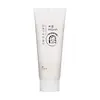What's inside
What's inside
 Key Ingredients
Key Ingredients

 Benefits
Benefits

 Concerns
Concerns

 Ingredients Side-by-side
Ingredients Side-by-side

Oryza Sativa Bran Water
MaskingMyristic Acid
CleansingGlycerin
HumectantWater
Skin ConditioningPotassium Hydroxide
BufferingPalmitic Acid
EmollientStearic Acid
CleansingRice Bran Acid
CleansingLauric Acid
CleansingGlyceryl Stearate
EmollientCocamidopropyl Betaine
CleansingPotassium Cocoyl Glycinate
Dipropylene Glycol
Humectant1,2-Hexanediol
Skin ConditioningOryza Sativa Bran Extract
Skin ConditioningXanthium Strumarium Fruit Extract
Skin ConditioningPortulaca Oleracea Extract
Skin ConditioningAzadirachta Indica Leaf Extract
Skin ConditioningGinkgo Biloba Leaf Extract
Skin ConditioningAvena Sativa Kernel Extract
AbrasiveRhus Semialata Gall Extract
Skin ConditioningAkebia Quinata Extract
Skin ConditioningHydroxypropyl Starch Phosphate
Sodium Polyacrylate
AbsorbentPolyquaternium-7
PEG-100 Stearate
Butylene Glycol
HumectantSodium Chloride
MaskingChlorphenesin
AntimicrobialSodium Benzoate
MaskingDisodium EDTA
Oryza Sativa Bran Water, Myristic Acid, Glycerin, Water, Potassium Hydroxide, Palmitic Acid, Stearic Acid, Rice Bran Acid, Lauric Acid, Glyceryl Stearate, Cocamidopropyl Betaine, Potassium Cocoyl Glycinate, Dipropylene Glycol, 1,2-Hexanediol, Oryza Sativa Bran Extract, Xanthium Strumarium Fruit Extract, Portulaca Oleracea Extract, Azadirachta Indica Leaf Extract, Ginkgo Biloba Leaf Extract, Avena Sativa Kernel Extract, Rhus Semialata Gall Extract, Akebia Quinata Extract, Hydroxypropyl Starch Phosphate, Sodium Polyacrylate, Polyquaternium-7, PEG-100 Stearate, Butylene Glycol, Sodium Chloride, Chlorphenesin, Sodium Benzoate, Disodium EDTA
Water
Skin ConditioningGlycerin
HumectantSodium Cocoyl Glycinate
CleansingSodium Lauroyl Glutamate
Butylene Glycol
HumectantCoco-Betaine
CleansingBetaine
HumectantHydroxypropyl Starch Phosphate
Artemisia Vulgaris Extract
Skin ConditioningAspartic Acid
MaskingCitric Acid
BufferingSodium Chloride
MaskingCaprylyl Glycol
EmollientPolyquaternium-67
Artemisia Princeps Leaf Extract
Skin ConditioningMelia Azadirachta Leaf Extract
Skin ConditioningMalt Extract
Skin Protecting1,2-Hexanediol
Skin ConditioningMelia Azadirachta Flower Extract
Skin ConditioningCamellia Sinensis Leaf Extract
AntimicrobialSalvia Officinalis Oil
MaskingEthylhexylglycerin
Skin ConditioningAllantoin
Skin ConditioningMadecassoside
AntioxidantPanthenol
Skin ConditioningAsiaticoside
AntioxidantAsiatic Acid
Skin ConditioningWater, Glycerin, Sodium Cocoyl Glycinate, Sodium Lauroyl Glutamate, Butylene Glycol, Coco-Betaine, Betaine, Hydroxypropyl Starch Phosphate, Artemisia Vulgaris Extract, Aspartic Acid, Citric Acid, Sodium Chloride, Caprylyl Glycol, Polyquaternium-67, Artemisia Princeps Leaf Extract, Melia Azadirachta Leaf Extract, Malt Extract, 1,2-Hexanediol, Melia Azadirachta Flower Extract, Camellia Sinensis Leaf Extract, Salvia Officinalis Oil, Ethylhexylglycerin, Allantoin, Madecassoside, Panthenol, Asiaticoside, Asiatic Acid
 Reviews
Reviews

Ingredients Explained
These ingredients are found in both products.
Ingredients higher up in an ingredient list are typically present in a larger amount.
1,2-Hexanediol is a synthetic liquid and another multi-functional powerhouse.
It is a:
- Humectant, drawing moisture into the skin
- Emollient, helping to soften skin
- Solvent, dispersing and stabilizing formulas
- Preservative booster, enhancing the antimicrobial activity of other preservatives
Butylene Glycol (or BG) is used within cosmetic products for a few different reasons:
Overall, Butylene Glycol is a safe and well-rounded ingredient that works well with other ingredients.
Though this ingredient works well with most skin types, some people with sensitive skin may experience a reaction such as allergic rashes, closed comedones, or itchiness.
Learn more about Butylene GlycolGlycerin is already naturally found in your skin. It helps moisturize and protect your skin.
A study from 2016 found glycerin to be more effective as a humectant than AHAs and hyaluronic acid.
As a humectant, it helps the skin stay hydrated by pulling moisture to your skin. The low molecular weight of glycerin allows it to pull moisture into the deeper layers of your skin.
Hydrated skin improves your skin barrier; Your skin barrier helps protect against irritants and bacteria.
Glycerin has also been found to have antimicrobial and antiviral properties. Due to these properties, glycerin is often used in wound and burn treatments.
In cosmetics, glycerin is usually derived from plants such as soybean or palm. However, it can also be sourced from animals, such as tallow or animal fat.
This ingredient is organic, colorless, odorless, and non-toxic.
Glycerin is the name for this ingredient in American English. British English uses Glycerol/Glycerine.
Learn more about GlycerinHydroxypropyl Starch Phosphate is a modified starch used to help thicken a product.
It is also used in foods.
Chances are, you eat sodium chloride every day. Sodium Chloride is also known as table salt.
This ingredient has many purposes in skincare: thickener, emulsifier, and exfoliator.
You'll most likely find this ingredient in cleansers where it is used to create a gel-like texture. As an emulsifier, it also prevents ingredients from separating.
There is much debate on whether this ingredient is comedogenic. The short answer - comedogenic ratings don't tell the whole story. Learn more about comegodenic ratings here.
The concensus about this ingredient causing acne seems to be divided. Research is needed to understand if this ingredient does cause acne.
Scrubs may use salt as the primary exfoliating ingredient.
Learn more about Sodium ChlorideWater. It's the most common cosmetic ingredient of all. You'll usually see it at the top of ingredient lists, meaning that it makes up the largest part of the product.
So why is it so popular? Water most often acts as a solvent - this means that it helps dissolve other ingredients into the formulation.
You'll also recognize water as that liquid we all need to stay alive. If you see this, drink a glass of water. Stay hydrated!
Learn more about Water